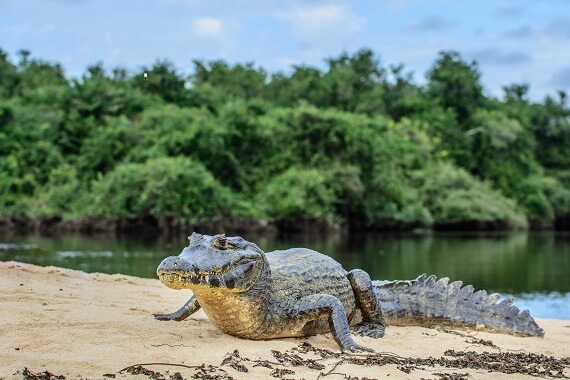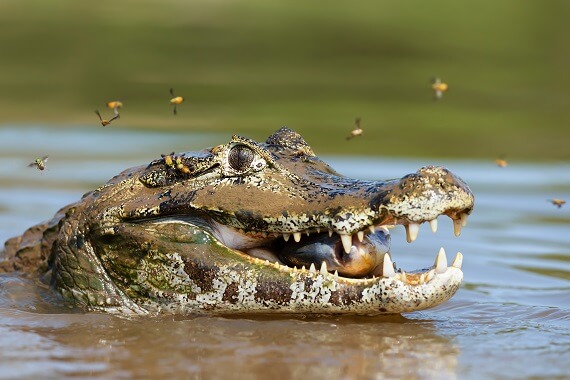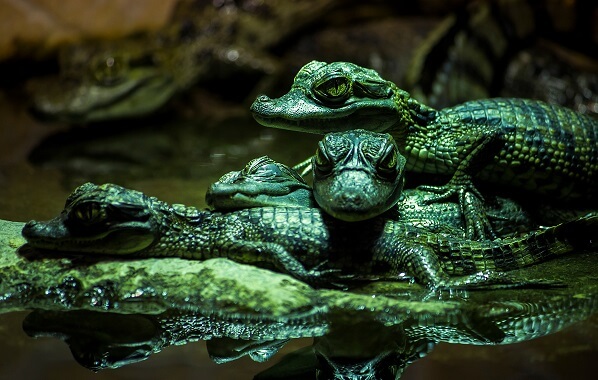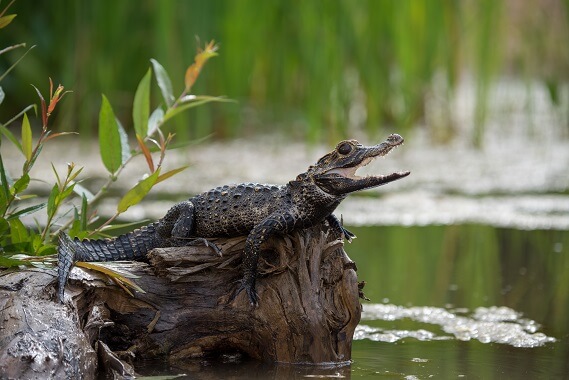
A caiman, or cayman, is any of several species of reptiles that belong to the family Alligatoridae. Six species of these reptiles belong to one of three genera; Caiman, Melanosuchus, and Paleosuchus. Caimans can be found in rivers, lakes, and swampland across Central and South America. Chile is the only South American country that caimans do not inhabit. Like other members of the Crocodilia order, caimans have been around for a really long time. They belong to a group of reptiles called archosaurs, which included the dinosaurs, and have evolved very little over the last 200 million years. While they have no close living relatives, they are most closely related to the alligator and share several characteristics with this giant, semi-aquatic reptile. Caimans have an oversized upper jaw, many sharp dagger-like teeth, and the inside of their mouth is orange in color. Alligators tend to have more conical shaped teeth, and the interior of their mouth is beige. Both alligators and caimans have a rounded snout. Caimans are generally much smaller than alligators. However one species – the black caiman – is on average larger at maturity. Adult male black caimans often grow longer than 13 feet ( approximately 4 meters)! The black caiman is the largest predator in the Amazon River basin. These reptiles are usually dull brown, grey, or green, which helps them to stay camouflaged in their environment. Caimans can not chew and so swallow smaller prey items whole. With larger prey items, they use their sharp teeth and powerful jaws to tear at the flesh. They are also known to store larger prey animals in underwater larders until the body tissue starts to decay, and becomes easier to eat. There are six species of caiman in total. These are: The different species are found in a variety of habitats and, in general, occupy different habitat niches, which means that there is rarely competition between species for territory. Spectacled caimans are by far the most common and are found all over Central and South America. They like to inhabit slow-flowing water, and aside from rivers, lakes, and swampland, they can also be found in human-made waterways such as reservoirs and canals. The black caiman, on the other hand, is much larger and so can withstand stronger currents. Caimans are successful predators that have been around since the time of the dinosaurs. Several biological adaptations have enabled these reptiles to persist as they are for millions of years. Let’s take a closer look at some of them. Caimans are very intelligent and can raise a large number of offspring at once. A nest can contain up to 65 eggs! The female lays her eggs in a nest made our of vegetation and soil. As the vegetation rots, it produces heat, which keeps the eggs warm. The sex of caiman offspring is determined by temperature – with warmer temperatures producing more females, and colder temperatures producing more males. The mother will often lay her eggs in a nest that has several layers to ensure she produces both male and female offspring. Once they hatch, the female nurtures her young for several months. Should anything happen to the mother, other female caimans will look after the babies. Caimans are semi-aquatic but are much better adapted for life in the water and are excellent swimmers. Like most crocodilians, caimans use their tail to propel them through the water. The tail is laterally flattened, so it has a relatively large surface area, which helps it to push against the water. The tail moves from side to side in a sinusoidal (s-shaped) pattern. The caiman uses its legs for steering. When the caiman moves at speed, its limbs are positioned flat against its body, making it much more streamlined. In this way, its the tail that provides all of the movement, and the caiman can use its tail to speed up very quickly. Aestivation or estivation is similar to hibernation, where animals enter into a period of dormancy to avoid extreme weather. The difference between these sleeping periods is that aestivation occurs in the summer when the weather is hot. Caimans will enter a period of aestivation during hot, dry weather as food and water become scarce. They will dig a burrow underground, where the climate is much cooler and more humid. Aestivating animals will wake up and become active again once temperatures cool. Aestivation usually only lasts a few weeks, unlike hibernation, which can last several months. Other animals that aestivate include cane toads, desert tortoises, and some species of salamanders.
Kingdom
Animalia
Phylum
Chordata
Class
Reptilia
Order
Crocodilia
Family
Alligatoridae
Genus
Caiman, Melanosuchus, and Paleosuchus
Species
6
Length
4.9ft – 19.7ft (1.5m – 6m)
Weight
13lbs – 660lbs (6kg – 300kg)
Lifespan
20 – 40 years
Social Structure
Social
Status
Least Concern
Preferred Habitat
Rivers, lakes, and swampland.
Average Clutch Size
30 – 65 eggs
Main food item
Fish, crustaceans, waterfowl, capybara
Main predators
Jaguars, wild pigs, birds of prey
The Basics

Fun Facts about Caimans!

Involved Mothers
Strong Swimmers

Aestivation
